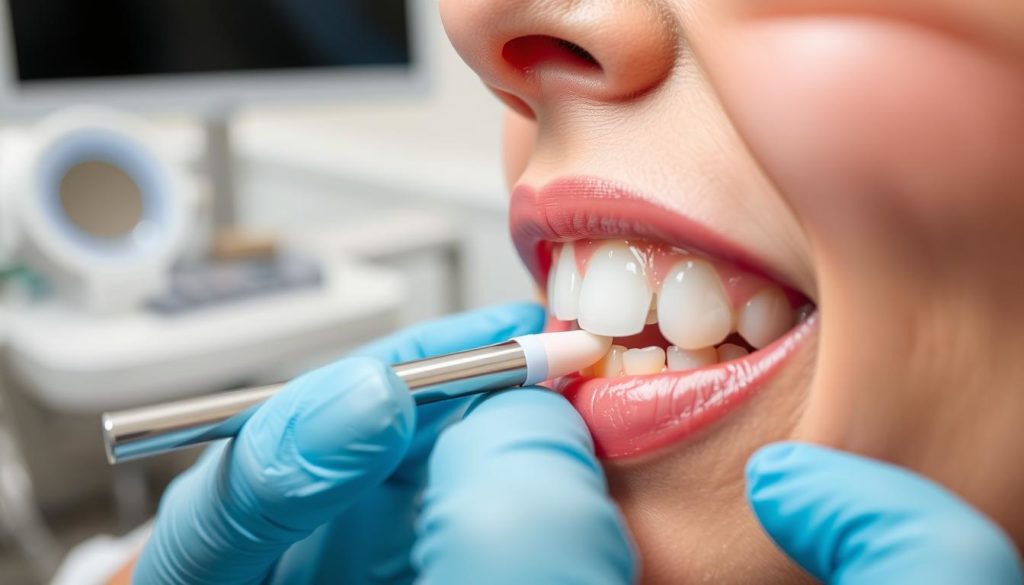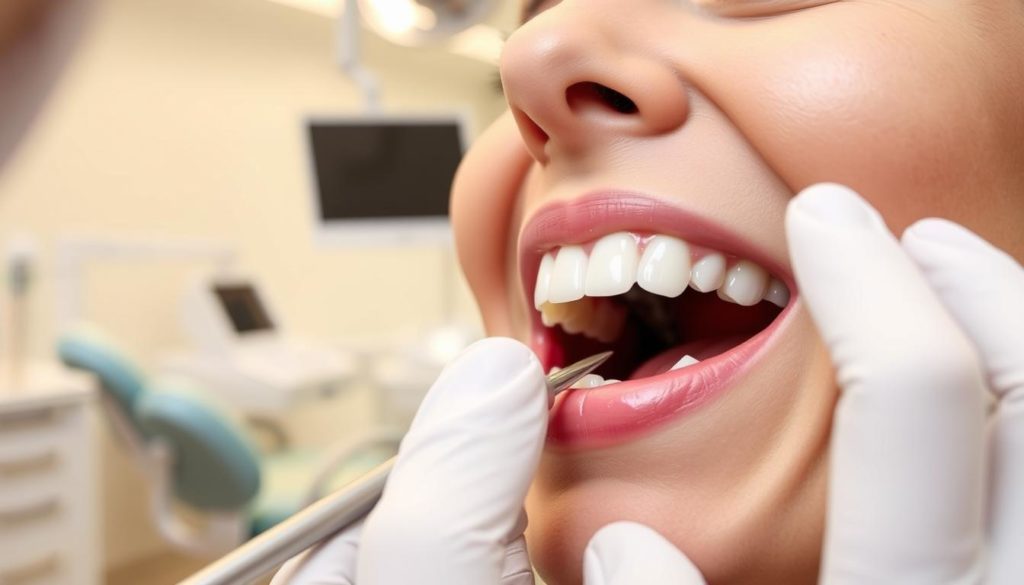Did you know that nearly 178 million Americans are missing at least one tooth? This huge number shows why cosmetic dentistry is so popular. Dental bonding is one of the top methods. It fixes problems like chips, cracks, or spaces, giving you a flawless smile.
Cosmetic dentistry offers many choices, but tooth bonding stands out. It’s less invasive and doesn’t cost as much. If you want a better smile without spending a lot, dental bonding could be the right pick. We’re about to dive into all the details of this amazing process.
What is Dental Bonding?
Dental bonding is a well-liked procedure in cosmetic dentistry. It involves applying a strong plastic material to a tooth. Then, a special light hardens and bonds the material to the tooth’s surface. This method works well for many tooth repair needs and is less invasive than other options.

The Basics of Tooth Bonding
The process starts with the dentist making the tooth’s surface rough. They apply a conditioning liquid to help the material stick. Then, resin is put on the tooth and hardened with a special light.
After that, the dentist shapes and polishes the material. This makes it look like the natural teeth around it.
How Dental Bonding Differs from Other Cosmetic Dentistry Procedures
Dental bonding stands out because it’s not invasive. It does not need much reshaping or removal of the tooth, unlike veneers or crowns. This keeps most of the natural tooth intact. Plus, it’s faster and costs less.
It offers a quick fix for small tooth repair and cosmetic changes. This is without the need for big dental procedures.
The Dental Bonding Procedure
The dental bonding process improves your smile quickly and easily. In just one visit, the dentist changes your teeth. This makes knowing about the steps comforting and helpful for you.

Step-by-Step Guide to the Dental Bonding Process
- Preparation: The dentist starts by getting the tooth ready. They roughen the tooth and use a special liquid so the material sticks better.
- Application of Bonding Agent: Next, the dentist puts on the bonding material. They shape it well and make sure it looks just like your real tooth.
- Curing with Light: Then, they use a special light. This light hardens the material quickly, making it strong.
- Final Shaping and Polishing: Last, the dentist shapes and polishes the tooth. This makes sure it fits perfectly with your other teeth.
What to Expect During Your Appointment
Your dental appointment may last one or two hours. It depends on how much work needs to be done. Usually, you won’t need any anesthesia unless it’s for a cavity. The dentist will make sure you’re comfortable and happy with how it turns out.
Reasons to Consider Dental Bonding
Dental bonding is great for many dental problems. It helps with chipped teeth, gaps, or discoloration. This method is simple and enhances your smile.
Addressing Chipped or Cracked Teeth
Fixing chipped teeth is a key reason for choosing dental bonding. Chipped or cracked teeth can worsen and harm your smile. Bonding uses a special resin to make the tooth look natural and strong again.
Fixing Gaps Between Teeth
Many feel self-conscious about dental gaps. Bonding is an easy, quick way to close these gaps. It makes your smile look better in just one dentist visit.
Improving Discolored Teeth
Dental bonding also works for teeth discoloration solutions. It covers stained or discolored teeth. This makes your smile whiter, especially if whitening treatments don’t work for you.
Benefits of Dental Bonding
Dental bonding has many advantages that make it a great choice for those wanting a better smile. It’s quick, almost painless, and one of the key dental bonding benefits. If you’re looking for affordable cosmetic dentistry, it’s an excellent option. There’s no need for long, complicated treatments.
Quick and Painless Procedure
Dental bonding stands out because it’s a painless dental procedure. Often, you won’t even need anesthesia, unless it’s for a cavity. The whole process can be done in about an hour. This is perfect for people who have a lot on their plate.
Let’s look at how dental bonding compares in time and discomfort to other dental work:
| Procedure | Time (Approx.) | Discomfort Level |
|---|---|---|
| Dental Bonding | 30-60 mins | Minimal |
| Veneers | 2-3 sessions | Moderate |
| Dental Crowns | 2-3 sessions | Moderate |
Cost-Effective Solution
Dental bonding is also very budget-friendly. It costs less than other affordable cosmetic dentistry choices like veneers or crowns. This means more people can afford to get their teeth looking great without spending a lot. Dental bonding can fix chips, cracks, gaps, and discoloration. All this, and it’s still a cheaper option.
Longevity and Maintenance of Bonding Agents
Learning about the lifespan of dental bonds and their upkeep is key for anyone thinking of getting them. Taking good care of bonding agents and your teeth can help make the bond last longer.
How Long Does Tooth Bonding Last?
Dental bonds can last from 3 to 10 years with the right care. The life of these bonds depends on factors like the tooth’s location, the way you bite, and your daily habits.
Tips for Maintaining Your Dental Bond
- Practice excellent dental care: Brush twice daily with fluoride toothpaste and remember to floss.
- Avoid biting or chewing on hard objects: This includes things like pen caps, nails, and ice to avoid damage.
- Limit intake of staining foods and beverages: Drinks like coffee, tea, and red wine can stain. Using a straw helps.
- Regular dental check-ups: Go for check-ups and cleanings to keep an eye on your dental bonds.
- Wear a mouth guard: If you grind your teeth while sleeping, a mouth guard can offer protection.
Following these tips not only extends the life of your dental bonds but also keeps your teeth healthy. Good maintenance and dental care can maintain your smile’s beauty for many years.
Is Dental Bonding Right for You?
To figure out if dental bonding is good for you, think about a few things. First, look at how much your tooth is damaged. Dental bonding works best for minor issues like small chips, cracks, or gaps. If the damage is big, you might need veneers or crowns instead.
What you want your smile to look like is also important. Dental bonding can make your teeth look natural. But, for big changes, like fixing a lot of discoloration or big gaps, you might need a different treatment.
Talk to your dentist to see if dental bonding is a fit for you. They will check your teeth closely. If dental bonding isn’t right for you, your dentist will help you find other ways to get the smile you want.
| Considerations | Dental Bonding | Alternative Options |
|---|---|---|
| Extent of Damage | Minor chips, cracks, gaps | Veneers, crowns for extensive damage |
| Aesthetic Outcome | Natural look for small refinements | Transformative change for severe discoloration |
| Personalized Care | Consult with your dentist | Explore other treatments if bonding is unsuitable |
By thinking about these things and talking to your dentist, you can figure out if dental bonding is right for you. You can also see if there are other treatments that might be better for your needs.
Comparing Dental Bonding to Other Cosmetic Dentistry Options
There are many ways to make your smile better. Dental bonding is a common choice because it’s quick and affordable. Porcelain veneers and dental crowns are other options with their own benefits.
Dental Bonding vs. Veneers
Veneers last longer than dental bonding. They are thin covers for the front of your teeth and look natural. Veneers don’t stain easily, but they do require removing some tooth structure. They also cost more.
| Feature | Dental Bonding | Porcelain Veneers |
|---|---|---|
| Durability | 5-10 years | 10-15 years |
| Cost | Lower | Higher |
| Procedure | Quick, usually one visit | Requires multiple visits |
| Aesthetics | Good | Excellent |
Dental Bonding vs. Crowns
Dental crowns offer great protection and look good. They cover the whole tooth and are great for badly damaged teeth. Crowns last longer and look better but are more invasive and pricey than bonding.
| Feature | Dental Bonding | Dental Crowns |
|---|---|---|
| Durability | 5-10 years | 15+ years |
| Cost | Lower | Higher |
| Procedure | Minimally invasive | Invasive, requires tooth shaving |
| Aesthetics | Good | Excellent |
Choosing the Right Dentist for Dental Bonding
Finding the right cosmetic dentist for dental bonding is key. This dentist should make your smile look better and keep your teeth healthy. It’s important they have a lot of experience in cosmetic dentistry, especially dental bonding. Success in dental bonding comes from the dentist’s artistic ability and careful attention.
Start by checking the dentist’s qualifications and their previous work. Looking at their dental bonding portfolio shows their skill level. It’s good to read personal reviews or look online to learn about their reputation. A dentist who offers comfort and uses modern techniques will make the process better and the results last longer.
When you meet with dentists, ask specific questions. Find out about their experience with dental bonding, what materials they use, and the aftercare they offer. This will help you see if they provide quality dental care. Picking the right dentist means a happier and more confident smile for you.
FAQ
What exactly is dental bonding?
Dental bonding fixes teeth with a tooth-colored resin. It repairs chips, cracks, and gaps. This dental treatment makes your smile better.
How does dental bonding compare to other cosmetic dentistry procedures?
Dental bonding is special because it’s quick and gentle. It usually needs just one visit. Bonding is less pricey than veneers or crowns, yet still offers a lovely smile.
What can I expect during the dental bonding procedure?
First, the dentist gets your tooth ready. They then apply and shape the resin. Finally, a special light hardens it. It’s usually done in one painless visit.
Why might someone need dental bonding?
It’s great for fixing chipped or cracked teeth, closing gaps, and hiding discoloration. Dental bonding can significantly enhance your smile.
What are the main benefits of dental bonding?
The benefits are its speed, being pain-free, and low cost. It greatly improves how your smile looks. Dental bonding is an easy choice for cosmetic dental fixes.
How long does tooth bonding last?
Dental bonding can last for years if you care for it well. Keeping up with oral hygiene and avoiding damaging habits are key to its longevity.
How can I maintain my dental bond?
Keep your dental bond strong by brushing and flossing daily. Also, don’t bite hard things and see your dentist regularly. These steps will keep your bond in top shape.
Is dental bonding the right option for me?
Whether dental bonding is good for you depends on your teeth’s condition and your goals. Talk to your dentist about it. They will help choose the best option for you.
How does dental bonding compare to veneers and crowns?
Bonding is less invasive and cheaper than veneers and crowns. While the others last longer and have their own benefits, bonding quickly fixes minor flaws at a lower cost.
How should I choose a dentist for dental bonding?
Choose a cosmetic dentist skilled in dental bonding. Look at their credentials and reviews. Their artistry is important for a natural-looking bond. Discuss their experience with you to feel safe and confident.


